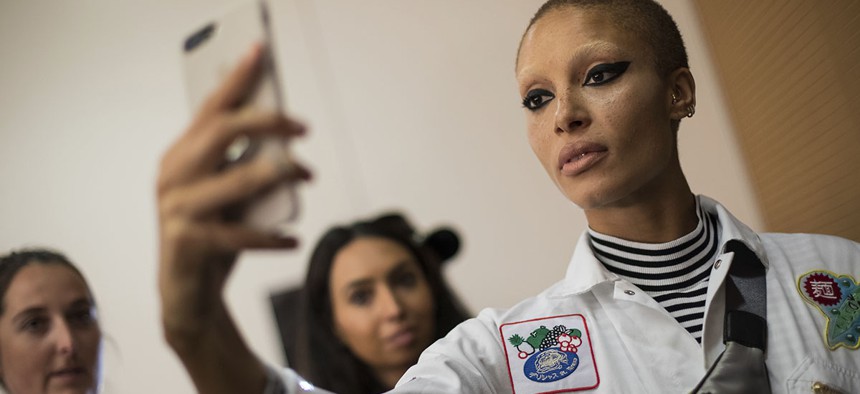Front-Facing Cameras Were Never Intended for Selfies

Model Adwoa Aboah takes a selfie backstage prior to the Versus Spring/Summer 2018 runway show at London Fashion Week in London, Sunday, Sept. 17, 2017. Vianney Le Caer/AP
Developers had something else in mind.
In 2003, Sony introduced a squat, flip phone that would’ve been forgotten if not for its 0.3 pixel camera that could be turned to face the caller: The Ericsson Z1010 was the first mobile device with a front-facing camera. Little did designers know that this simple feature, intended to enhance business meetings, would usher in the age of selfies.
Social-media platforms and photo-sharing apps like Instagram would make the selfie the lingua franca for millennials. It was the perfect format for the mobile, DIY-minded, and social-media savvy generation. By turning the camera on oneself, the user became the model, the photographer, the art director, the image retoucher, and the publisher of their image. The casual self-portraiture format—at times aided by a long, retractable stick—became so ingrained in daily life that Oxford Dictionaries named “selfie” as the 2013 word of the year.
The numbers vary, but they’re all too big to ignore. Google estimated in 2014 that over 93 million selfies are taken every day on Android devices, and in her book Je Selfie Donc Je Suis (I Selfie Therefore I Am), psychoanalyst Elsa Godart estimates that young adults will take a staggering 25,700 selfies in their lifetime. Before the selfie mode was invented, people were more sparing with their self portraits.
But front-facing cameras were never intended for vanity. Sony’s mobile-phone designers, for instance, thought the camera-flip feature would be used for video-conference meetings so that users would no longer have to be tethered to a desktop or laptop to convene Skype calls.
When Steve Jobs unveiled the iPhone 4 in 2010, he demonstrated the new front-facing camera’s intended use by making the first FaceTime call to Jony Ive, Apple’s chief design officer. “I grew up here in the US with The Jetsons and Star Trek and communicators, and just dreaming about this—dreaming about video calling—and it’s real now,” Jobs gushed.
The wifi slowed down during that historic call, straining their casual banter. During the awkward lag, Ive, grinning in front of a modern-art painting, essentially modeled how great the iPhone camera would be for snapping selfies.
By 2015, Apple formally acknowledged how much users turned their high-definition cameras toward themselves by introducing a dedicated folder for selfies in Photos. For the first time, selfie lovers’ vanity was quantified and tagged. But the world was not ready for such an honest mirror. Among the most googled queries for iOS 9 was, “How do I delete the selfie folder?”





